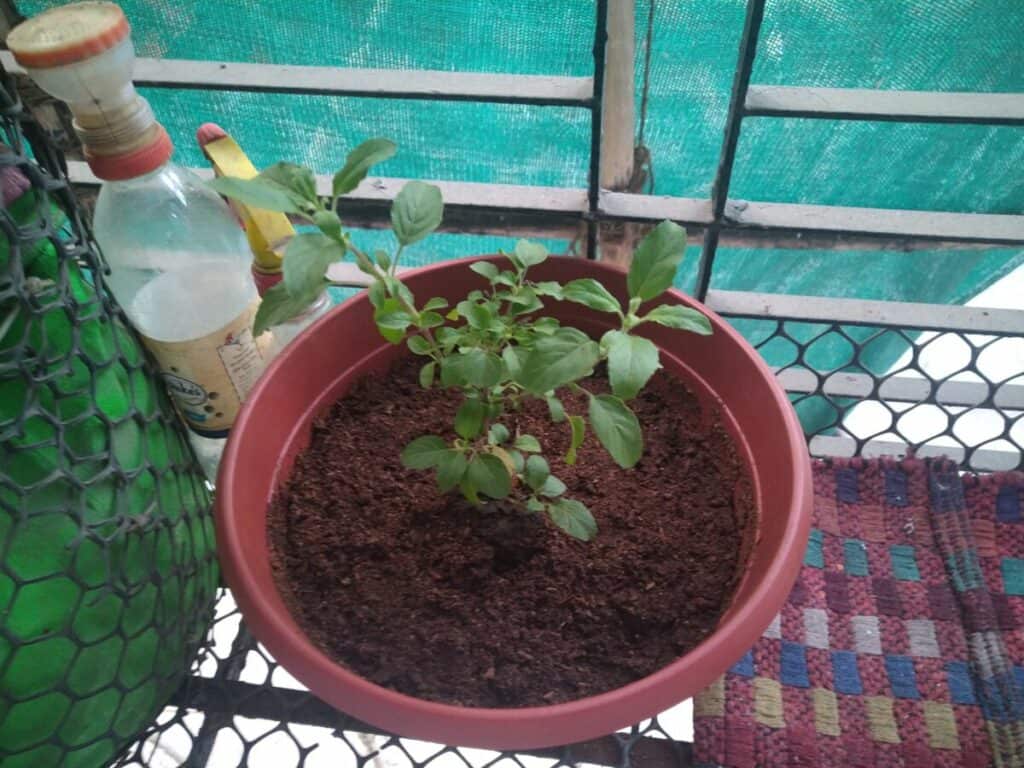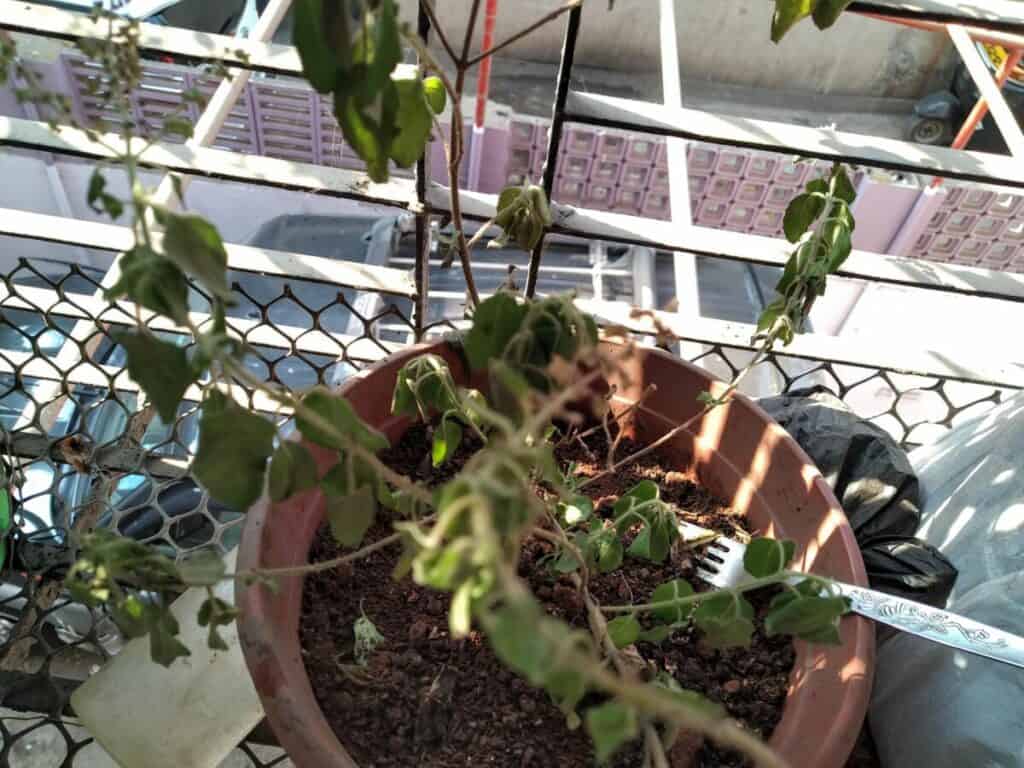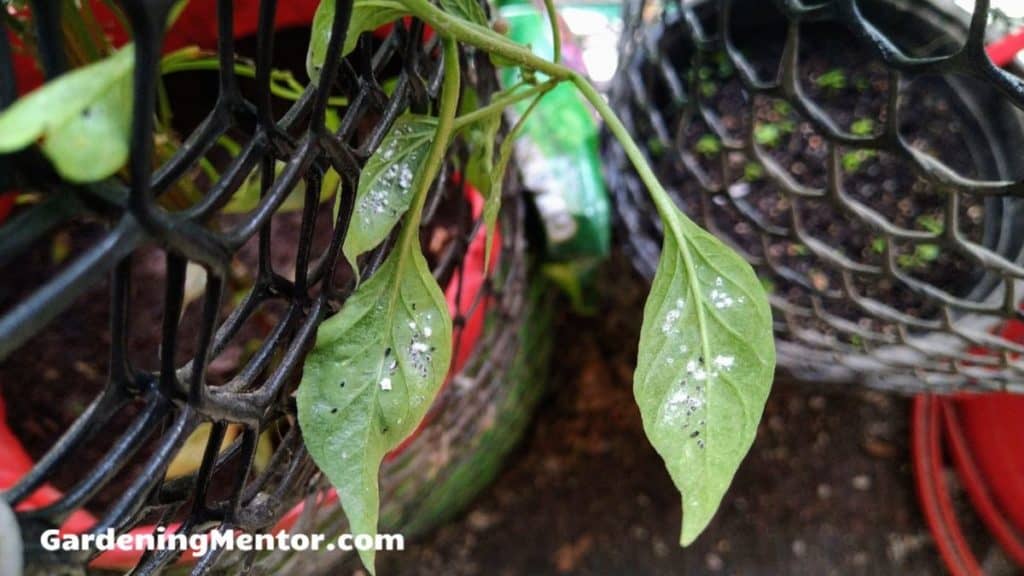I like to grow basil in my garden because of its taste and fragrance. It adds a good flavor to my Indian dishes. But I found that my basil starts to wilt after a transplant to my container garden. And I wanted to figure out why this happens.
Your basil is wilting after transplant because of transplant shock. This happens because the basil plant is unable to adjust to the change in environmental conditions such as sunlight, heat, and wind. The plant could have damaged roots causing the wilting.
I’ve written a lot more details that will help you understand each of these problems and what you can do to protect your basil plant from wilting.
Why Is Your Basil Wilting After Transplant?
Basil is easy to grow, and it even flourishes indoors, like inside your kitchen or anywhere in your house as long as it can get sunlight for at least eight hours. But if you relocate it outdoors for some reason, you might find it starting to wilt after you transplant it.
Should you worry? Wilting is a bad omen for plants but seeing their leaves droop is not the end of the world. To remedy it, you will need to get to the cause of the problem.
A Lot of Its Roots Got Damaged During Transplant
You may have started the basil from seed or bought the seedling from a local garden center or nursery. When you try to transplant it to a container or in-ground garden, it’s possible that some of the roots get damaged.
If the roots suffer such damage, they will not be able to supply the required nutrients and moisture from the soil to the plant causing the basil leaves to wilt.

Too Much Watering
Overwatering is a common problem that a beginner gardener is guilty of. We like to take care of our plants and feel giving it a lot of water is beneficial. But overwatering will cause the roots to drown.
There will be a lack of air circulation through the soil and the roots so they won’t be able to extract the nutrients and moisture for the plant. This lack of nutrients will cause the leaves to wilt. They may even get blisters full of water that burst.
I suggest checking the moisture in the soil before watering the basil plant by putting your finger 1-2 inches in the soil. You do need to water well after the transplant but make sure that the soil does not turn soggy.

Root Rot And Diseases
One of the dangers of overwatering your basil is that its roots will rot due to an attack by a fungal disease. With damaged roots from the transplanting, your basil will have fewer roots to absorb water and nutrients. This will cause it to wilt.
But with root rot, the remaining roots are destroyed even further, which means that your basil will have even lesser capability to draw in water from the soil. In this case, watering your basil will only cause it to wilt even further and root rot will take hold.
If the basil plant is infected with fungal, bacterial, or viral diseases, the leaves may wilt. It’s best to prevent such diseases from attacking the plant.
To prevent fungal diseases, make sure to keep the plant foliage dry and avoid splashing water or the soil on it. The moist environment is the cause of attracting such diseases.
To prevent bacterial and viral diseases, protect your basil plant from pests that eat up the plant and transmit such diseases. You can also try to get a basil variety that is resistant to some of the common diseases.
Sunburn
You need to protect your basil plant from too much heat from the sun. If it’s too hot, the basil leaves will wilt and may even burn.
You can grow the basil plant in early spring or late summer when the heat is not too much. You can use a row cover to protect your plant from the heat. If you’re growing the basil in a container, you can move it in the shade during the afternoon.
Transplant Shock
Transplant shock is another reason why your basil is wilting. Transplant shock can happen when you re-plant a seedling or relocate your herb. Sometimes, even simple topdressing or repotting can cause transplant shock.
Transplant shock may also be caused by changes in the environment and physically cutting the roots, stems, and other parts.
Aside from wilting, transplant shock may also cause dying branches or falling flowers and fruit. Worse comes to worst, your basil might die due to transplant shock.
Avoiding Transplant Shock
If you want to avoid transplant shock in your basil, you shouldn’t disturb the roots too much when you transplant. Don’t shake or bump the root ball and be gentle with the roots.
If you can, you should bring as much of the root system to the transplant. This will give your basil a good chance of surviving and will keep it from wilting.
You should also water the newly transplanted basil thoroughly and make sure that the root ball stays moist.
Recovering From Transplant Shock
If transplant shock does occur, you can add some sugar to the transplanted herb. You can dissolve a little sugar in water to make a weak solution and then pour it into the soil.
You can also trim back some leaves and stems off your basil and be sure to keep the roots moist. Other experts also advise just waiting for your plant to recover by itself.
Make sure you don’t add fertilizer to the basil plant that is suffering from transplant shock as it may get even more stressed.
What to Do if Your Basil Wilts After Transplant
If you have transplanted your basil and have ensured that very few roots get damaged and that you water it correctly, but it’s still wilting, then here are some things that you can try.
- Check the soil pH. Basil thrives in soil with a pH level between 5.5 and 7.5.
- Make sure it gets full sun. Place your basil where it can get anywhere from six to eight hours of sun every day.
- Water sufficiently. Basil needs the soil just moist, not wet and soggy.
- Check for diseases. Aside from root rot, basil plants wilt because of several diseases. One of the more common is fusarium wilt, which is caused by fungi. Unfortunately, there is no remedy for fusarium wilt.
- Get rid of insects. Several insects are known to attack basil, including mites, aphids, cutworms, or whiteflies. Slugs and snails can also attack the herb. It’s best if you use horticultural soaps or oils to kill these insects. You can also handpick snails and slugs when you see them. Moreover, you can blast these insects with strong jets of water to keep them off the plant. Furthermore, cover your basil with garden fabric to prevent infestation.

How to Transplant Your Basil Correctly
If you are transplanting newly purchased basil plants or the ones you’re growing by your kitchen window, you will need to let them be accustomed to the sunlight outside to avoid giving them sunburn.
Before transplanting your plants, put them outdoors where they can get bright but indirect sunlight for a few hours or for the entire day, but bring them in when night falls. This will help your basil plant to harden off, and eventually be able to fight off the heat of the sun.
Water the newly transplanted basil only when the soil begins to dry to avoid overwatering it. Spread compost that is an inch thick over your garden bed and work it into the top six inches of the soil. The area should have at least five hours of sunlight throughout the day.
Once you are ready, you should dig planting holes that are as deep as the basil’s pot and give it an allowance of one to two inches in width. Proper spacing should be 18 inches between two plants.
Cup the pot with your hands, securing the basil stems in between your fingers. You can squeeze the pot if possible so the basil can just slide out of it.
Then put the entire transplant into the hole and close the hole with soil. Pat the soil around the plant stem firmly.
Water the newly transplanted basil around the soil to make sure that the root zone is moist. Be sure not to overwater it so that it turns soggy.
Transplanting a Basil Plant Grown by Hydroponics
If you have basil plants grown via hydroponics, you can transplant these onto the soil if you like using pots that are around four to six inches wide. You can prune larger bunches so that the nutrients and the water can focus on a smaller area and keep it alive.
Remember, however, that a new growing medium will mean that you will need to water the basil more frequently. Hydroponic plants will need more water than those grown in soil. Watering will not only give it the right amount of water it needs, but it can also prevent shock.
Slowly cut back on watering your basil until you only need to water when the topmost layer of soil is dry. As with transplanting basil grown from the soil, you will need to let it harden off by placing it in a sunny window before fully placing it outside.
Final Thoughts
Basil is a very useful plant and growing your own will certainly help you save money, while also making sure you have enough of the plant for your cooking needs. You can transplant it to save space in your kitchen.
Plants like basil, however, are not meant to move around, and this is why your basil sometimes wilts after you relocated it. The good news is that it is probably temporary and is just caused by not acclimatizing your basil, by watering it too much, by root rot, or by damaged roots. Give it a few days and try to address the underlying causes to get your basil back to health.

Fact Checked, Written, and Published by Kevin Rodrigues
Kevin is the founder of Gardening Mentor, a website that aims to teach people to grow their own food in a limited space. As a self-taught gardener, Kevin has spent several years growing plants and creating gardening content on the website. He is certified in Home Horticulture and Organic Gardening from Oregon State University. He has a Post Graduate Diploma in Horticulture and Landscape Gardening from Mumbai University.
Read more
